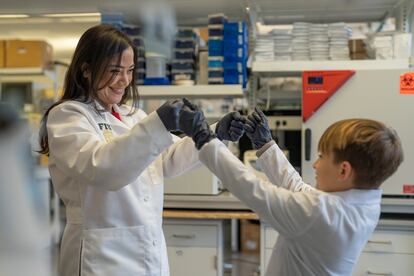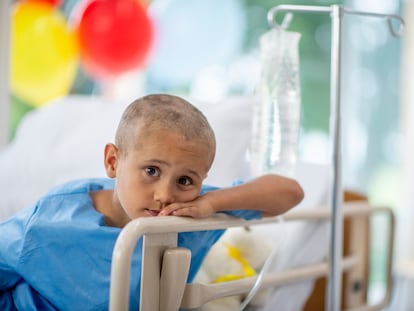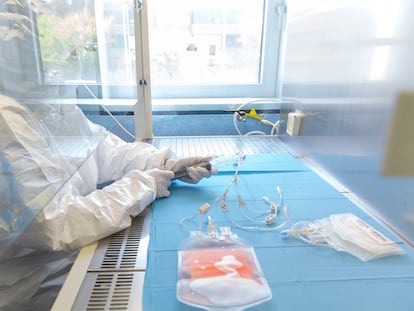Leukemia: A plan to find the most precise treatment for little Logan’s aggressive cancer
U.S. researchers tested a hundred drugs on patients’ tumor cells in the lab to identify the most effective drugs for their cancer

Childhood cancer is rare but devastating, arising from some random alteration during embryonic development: some cells do not quite work properly and, at some point, begin to grow uncontrollably until they form a tumor. It is an uncommon disease — there is one case for every 200 in adults — and although 80% of patients are cured, in some children the tumor returns and therapeutic alternatives are exhausted. The scientific community struggles to tackle the initial pediatric cancer as well as relapses, like little Logan Jenner’s. Logan was diagnosed with acute myeloid leukemia at the age of three, and after 14 months of treatment, it reappeared. Without many other treatment options, the boy embarked on an experimental plan designed by researchers at Florida International University to find the most accurate treatment for his aggressive leukemia. The project consisted of testing a hundred drugs on the tumor cells of patients in the laboratory and identifying the most accurate drug for killing them in the patient’s body; the study’s results were published on Thursday in Nature Medicine. The research project, which is still in very early stages and includes few patients, worked with Jenner and the little boy, now eight years old, has been cancer-free for two years.
No two tumors are the same: each has its own molecular particularities, a more or less protective microenvironment, resistance mechanisms and Achilles’ heels. Oncologists know this and in recent years, they have shifted toward an extremely personalized therapeutic approach to cancer with increasingly targeted treatments. In pursuit of a window of opportunity to attack the most resistant childhood tumors, researchers at Florida International University have also developed a new precision approach in which they combine genetic analysis of the tumor with a system of individualized drug analysis—they have a range of 120 treatments, oncological or otherwise, approved by the US Food and Drug Administration (FDA)—to find the best therapeutic option against cancer cells. This preliminary research’s goal was to see the feasibility of using this molecular-guided precision oncology to decide on the treatment of refractory pediatric tumors that no longer respond to conventional therapies.
“Each individual is different, and we need to be able to identify and understand the unique properties of [each] patient’s tumor. By personalizing cancer treatments, we will be more precise and provide safer treatment options. Current treatments are based on a one-size-fits-all approach, and that’s not ideal because each patient responds uniquely to drugs,” states Diana Azzam, a researcher in the Department of Environmental Health Sciences at Florida International University and the architect of this research. To test their technique, Azzam’s team recruited twenty children with various recurrent tumors, from Jenner’s myeloid leukemia to glioblastomas, Ewing sarcomas and neuroblastomas, among others. All had already received several lines of treatment to try to contain their tumors, but they had relapsed.
The researchers took samples of the participants’ tumors to the laboratory to make them grow, reproducing the natural evolution they would undergo in the human body, in order to test a hundred or so drugs on them. In addition, they conducted genomic profiling of these tumors, looking for alterations in the DNA of the cancer cells that could serve as potential therapeutic targets. “First of all, this has helped us to review what is going on in the patient’s tumor, as well as to offer many options for each individual. It allows us to test many drugs in a short turnaround time,” explains Azzam.
In scarcely 10 days, the combination of the genomic results and the differing response of the patient’s cancer cells to the drugs to which they are exposed allowed the researchers to translate the most effective therapeutic plan for each patient to oncologists. “Patients who were guided by our test actually did better compared to their own previous regimens and compared to patients who were not guided by our approach. We have shown that whatever works in the tumor in the laboratory really works in the patient,” the researcher enthuses.
According to the scientists, 21 patients underwent these drug sensitivity tests, and 20 participants also completed genomic analysis. The researchers returned treatment recommendations for 19 of them; of those, 14 received therapeutic interventions: in eight cases, the oncologists were not guided by the indications that the project reported, but they were for the other six patients and five of them improved. Logan is one of them.
The little boy had been battling an aggressive myeloid leukemia since he was three years old, and it kept coming back. He had undergone several cancer treatments as well as a bone marrow transplant, but he relapsed again. After entering the study, his doctors treated him with the therapeutic options recommended by the Azzam model and, in just 33 days, he went into remission. “He was able to receive a second bone marrow transplant and has been cancer-free for two years now,” says Arlet Maria de la Rocha, co-author of the study. His mother, Diana Jenner, keeps the results of all the tests around the house and even wants to frame the trial results: “I don’t think my son would be here without this study,” she reflects.
In Logan’s case, Azzam says, the research yielded three findings that could play in his favor. For one thing, the little boy had a specific mutation in his tumor for which several inhibitors are available, but with the trial-and-error of drugs in the laboratory, the researchers were able to select the most effective treatment for the child. Another positive effect is that they could show that some drugs he would have been given were not going to be effective: “We were able to tell his doctor which drugs might not be effective, and that helped her make the decision to withdraw drugs that she thought might work in Logan’s case, but that ultimately turned out to be ineffective and might have toxic effects,” Azzam relates. The study of his case also found that the little boy’s tumor cells produced “an unexpected increase with commonly used steroids”; those drugs are used to suppress the immune system when a marrow transplant is performed. “Our results showed that steroids actually increased the growth of cancer cells. And that could have been counterproductive,” she says. That finding made it possible to withdraw this drug at his second transplant to avoid undesirable effects.
More treatment options
The researchers admit that their findings are preliminary and require larger studies with more patients, but they highlight the benefits of their technique. One advantage is turnaround time, as they can return results to oncologists in as little as a week. “This is very important because these patients do not have the luxury of time; they have exhausted all the treatments and every day counts,” says De la Rocha. Since many drugs are tested at the same time, this therapeutic approach also makes it possible to offer many more treatment options, the researchers emphasize. And they stress that the laboratory results are a mirror of what would happen in the body.
In addition, the research once again focused on drug repurposing, which consists of exploring the potential reuse of known drugs for other therapeutic indications. “When we look at these tumors in the lab and look at hundreds of drugs, we find drugs that are widely available, that may not be approved for that particular indication or tumor type, but can be repurposed to effectively treat another resistant tumor,” Azzam says.
‘A promising technology’
Lucas Moreno, the head of Pediatric Oncology at Vall d’Hebron, believes this approach is “a promising technology,” but he emphasizes that it is still in its infancy and “it needs to be expanded to larger studies and in more specific tumors.” He adds that “success cannot be measured yet; the results are not enough to make a comparison with other approaches.” Nevertheless, the oncologist, who did not participate in the study, underscores its potential usefulness, especially in a type of tumor where genomic profiling alone may not be sufficient: “Most pediatric tumors do not depend on a genomic alteration that is easy to treat. And when you do genomic studies, you don’t find an answer,” he explains.
The physician notes that one of the study’s limitations may be the tumor’s own heterogeneity, and the fact that the growth of cancer cells in the laboratory is a different environment from the human body, so the results may not be 100% similar. For her part, Azzam aims to extend the implementation of her approach beyond a relapse context and even take it to the doorstep of diagnosis. “To achieve this, we need to be able to demonstrate in large-scale clinical trials that our test offers a lot of value compared to genomics alone and compared to standard treatment. So, there is a lot of work to be done,” she says.
Sign up for our weekly newsletter to get more English-language news coverage from EL PAÍS USA Edition
Tu suscripción se está usando en otro dispositivo
¿Quieres añadir otro usuario a tu suscripción?
Si continúas leyendo en este dispositivo, no se podrá leer en el otro.
FlechaTu suscripción se está usando en otro dispositivo y solo puedes acceder a EL PAÍS desde un dispositivo a la vez.
Si quieres compartir tu cuenta, cambia tu suscripción a la modalidad Premium, así podrás añadir otro usuario. Cada uno accederá con su propia cuenta de email, lo que os permitirá personalizar vuestra experiencia en EL PAÍS.
¿Tienes una suscripción de empresa? Accede aquí para contratar más cuentas.
En el caso de no saber quién está usando tu cuenta, te recomendamos cambiar tu contraseña aquí.
Si decides continuar compartiendo tu cuenta, este mensaje se mostrará en tu dispositivo y en el de la otra persona que está usando tu cuenta de forma indefinida, afectando a tu experiencia de lectura. Puedes consultar aquí los términos y condiciones de la suscripción digital.
More information
Archived In
Últimas noticias
Most viewed
- Reinhard Genzel, Nobel laureate in physics: ‘One-minute videos will never give you the truth’
- Oona Chaplin: ‘I told James Cameron that I was living in a treehouse and starting a permaculture project with a friend’
- Pablo Escobar’s hippos: A serious environmental problem, 40 years on
- Why we lost the habit of sleeping in two segments and how that changed our sense of time
- Chevy Chase, the beloved comedian who was a monster off camera: ‘Not everyone hated him, just the people who’ve worked with him’











































